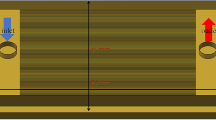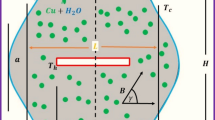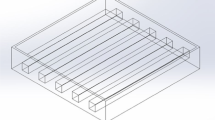Abstract
The temperature field in the full 3D finite element mold model (FEMM) combined with submerged entry nozzle (SEN) (Full SEN-3D FEMM) is simulated by using Fluent of ANSYS 18.0 Package. The maximum heat flux on the heat face of mold copper plate obtained through this simulation is applied to the element model of the copper plate, and thermal stress and strain simulations on the copper plate and stainless back ones are conducted with Workbench of ANSYS 18.0 Package, confirming the reasonable designing factors for the water slot structure on the copper plate. The maximum heat flux on the wide and narrow heat faces of the copper plates is given on the initial shock areas of molten steel flux injected through SEN. With constant heat flux on the heat face, the more thickness of copper plate increases, the more the max and min temperatures increase, and the difference between them decreases. Elastic and plastic deformations on the copper plate are made during continuous casting (CC) process; the former occurs around water slots and the latter around heat face. The cooling water slots depths of mold copper plate must be designed for minimizing of elastic and plastic deformations.















Similar content being viewed by others
Data availability
The authors confirm that the data supporting the findings of this study are available within this article.
Code availability
The code that support the findings of this study are available from the corresponding author [Sang Chol Om], upon a reasonable request.
References
Wang TM, Cai SW, Xu J, Du YY, Zhu J, Xu JJ, Li TJ (2010) Continuous casting mould for square steel billet optimised by solidification shrinkage simulation. Ironmak Steelmak 37(5):341–346
Pandey JC, Manish R, Rajesh M, Tripathy VK, Bandyopadhyay N (2008) Failure of nickel coating on a copper mold of a slab caster. J Fail Anal Preven 8:3–11
Mujun L, Huabiao C, Chen Dengfu Yu, Sheng LB, Huamei D (2018) A combined hybrid 3-D/2-D model for flow and solidification prediction during slab continuous castinG. Metals 8:182–191
Xudong L, Miaoyong Z (2006) Finite element analysis of thermal and mechanical character in a slab continuous casting mold. ISIJ Int 46(11):1652–1659
Xiangning M, Miaoyong Z (2009) Thermal character of hot copper plates for slab continuous casting mold with high casting speed. ISIJ Int 49(9):1356–1361
Xie X, Dengfu C, Haijun L, Mujun L, Lv K (2014) Mathematical modeling of heat transfer in mold copper coupled with cooling water during the slab continuous casting process. Metallurgival Mater Trans 45(12):2442–2452
Xudong W, Ling T, Xinyang Z, Man Y (2012) Mold transient heat transfer character based on measurement and inverse analysis of slab continuous casting. J Mater Process Technol 212:1811–1818
Feifei R, Hui Z, Weining W, Minglin W (2015) Numerical simulation of actual temperature field for chamfered mold copper. Iron Steel 50(4):27–33
Badri A, Natarajan TT, Snyder CC, Powers KD, Mannion FJ, Cramb AW (2005) A mold simulator for the continuous casting of steel: Part I. The Development of a Simulator. Metallurgical Mater Trans B 36B(6):355–371
Fengming D, Xudong W, Man Y, Xiaobing Z (2014) Analysis of the non-uniform thermal character in slab continuous casting mold based on the inverse finite-element model. J Mater Process Technol 214:2676–2683
Zhaozhen C, Miaoyong Z (2013) Thermo-mechanical character of peritectic steel solidifying in slab continuous casting mold and a new mold taper design. ISIJ Int 53(10):1818–1827
Zhenyu N, Zhaozhen C, Miaoyong Z (2019) Dynamic distributions of mold flux and air gap in slab continuous casting mold. ISIJ Int 59(2):283–292
Stone DT, Thomas BG (1999) Measurement and modeling of heat transfer across interfacial mold flux layers. Can Metall Q 38(5):363–375
Xudong W, Kong Lingwei Du, Fengming YM, XiaobingNG Z, Han Ma, Zhe W (2016) Mathematical modeling of thermal resistances of mold flux and air gap in continuous casting mold based on an inverse problem. ISIJ Int 56(5):803–811. https://doi.org/10.2355/isijinternational.ISIJINT-2015-601
Fengming Du, Wang Xudong Fu, Jingguo HX, Jiujun Xu, Man Y (2018) Inverse problem-based analysis on non-uniform thermo-mechanical behaviors of slab during continuous casting. Int J Adv Manuf Technol 94:1189–1196
Liu Yu, Wang Xudong Du, Fengming YM, Yali G, Fuwang W, Junyao W (2017) Computer vision detection of mold breakout in slab continuous casting using an optimized neural network. Int J Adv Manuf Technol 88:557–564
Luk’yanov SI, Suspitsyn ES, Krasilnikov SS, Shvidchenko DV (2015) Intelligent system for prediction of liquid metal breakouts under a mold of slab continuous casting machines. Int J Adv Manuf Technol 79:1861–1868
Éldarkhanov AS, Nuradinov AS, Uzdieva NS, Nuradinov IA (2019) Optimization of thermal performance of CCM mold. Metallurgist 63(1–2):11–20
Xiangning M, Miaoyong Z (2013) Effect of cooling structure on thermal character of copper plates of slab continuous casting mold. J Cent South Univ 20:318–325
Zhou J, Peng X, Qin Y (2009) A coupled thermal–mechanical analysis of a mold-billet system during continuous casting. Int J Adv Manuf Technol 42:421–428
Mingnan D, Changbao F, Jianhua Y, Wei Y, Ke Y (2008) Thermal and mechanical couple stress analysis of mould copper for slab continuous casting. Iron and Steel 43(5):30–34 ((in Chinese))
Luo W, Yan B, Lu X, Wen GH (2013) Improvement of water slot design for beam blank casting mould. Ironmak Steelmak 40(8):582–589
Zhang T, Yang J, Jiang P (2019) Measurement of molten steel velocity near the surface and modeling for transient fluid flow in the continuous casting mold. Metals 9:36–50
Launder BE, Spalding DB (1974) The numerical computation of turbulent flows. Comput Methods Appl Mech Eng 3:269–289
Jayatillaka C (1969) The influence of Prandtl number and surface roughness on the resistance of the laminar sublayer to momentum and heat transfer. Prog Heat Mass Transfer 1:193–321
Zhaozhen C, Miao-yong Z (2014) Non-uniform heat transfer character during shell solidification in a wide and thick slab continuous casting mold. Int J Miner Metall Mater 121(3):240–250
Acknowledgements
The authors would like to express their gratitude to the editors, the authors of the references, and the reviewers for their helpful suggestions for improvement and publication of this paper.
Author information
Authors and Affiliations
Contributions
Sang Chol Om presented the idea about building of full 3D finite element mold model combined with submerged entry nozzle (SEN) (Full SEN-3D FEMM), differently with applying the heat flux density obtained by empirical formula reported in previous literatures to hot face of copper plate as constant, and obtained the optimum plan about the cooling water slot structure of mold copper plate, synthesizing the simulation results from the each simulation steps.
Dong Gil Kim determined the process parameters for continuous casting and the properties of each materials used for the abovementioned Full SEN-3D FEMM and suggested the heat resistance model including the coating and mold flux layer between the molten steel and the mold copper plate.
Chung Il Pak determined the structure, the dimension and the submerged depth of submerged entry nozzle (SEN) applied for Full SEN-3D FEMM.
Hak Yong Kim simulated the flow and temperature fields about Full SEN-3D FEMM using Fluent Program in ANSYS Package to get the data about the maximum heat flux density and temperature field on the heat face of mold copper plate.
Il Un Kim simulated the thermal stress and strain fields in the element model using Workbench Program in ANSYS Package applying the maximum heat flux density in the results obtained from the simulation about Full SEN-3D FEMM to the heat face on copper plate in the element one.
Corresponding author
Ethics declarations
Ethics declarations
The authors approve to observe the ethics standard of this journal.
Conflict of interest
The authors declare no competing interests.
Open access
No open access.
Additional information
Publisher's note
Springer Nature remains neutral with regard to jurisdictional claims in published maps and institutional affiliations.
Rights and permissions
Springer Nature or its licensor (e.g. a society or other partner) holds exclusive rights to this article under a publishing agreement with the author(s) or other rightsholder(s); author self-archiving of the accepted manuscript version of this article is solely governed by the terms of such publishing agreement and applicable law.
About this article
Cite this article
Om, S.C., Kim, D.G., Pak, C.I. et al. A simulation method for the optimization of cooling water slot structure in slab continuous casting mold combined with submerged entry nozzle. Int J Adv Manuf Technol 127, 3221–3237 (2023). https://doi.org/10.1007/s00170-023-11671-z
Received:
Accepted:
Published:
Issue Date:
DOI: https://doi.org/10.1007/s00170-023-11671-z




